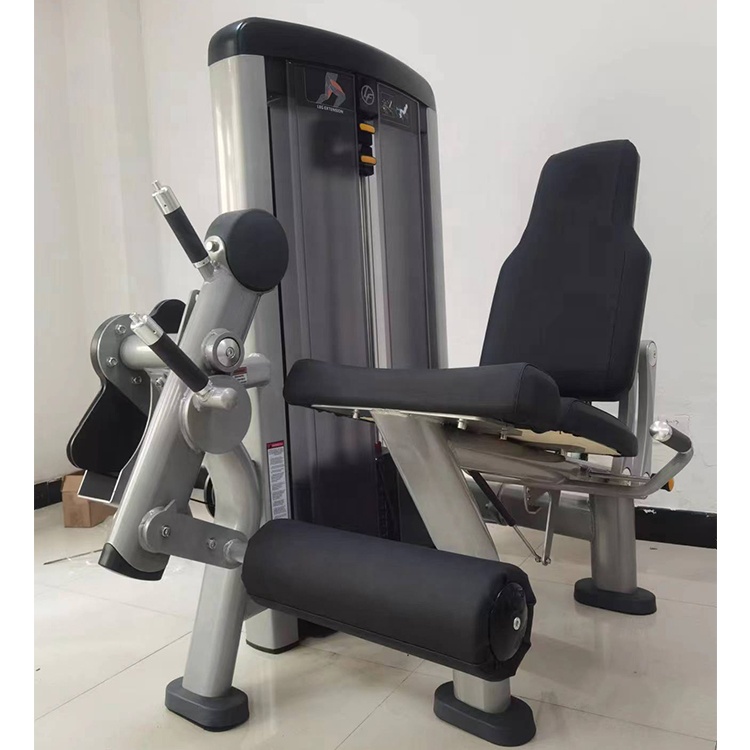The seated leg extension machine is a popular piece of Gym Equipment used for training and strengthening the muscles in the legs, particularly the quadriceps. Here is a step-by-step guide on how to use the seated leg extension machine: 1. Adjust the machine: Start by adjusting the seat height so that your knees are in line with the pivot point of the machine. This will ensure proper alignment and prevent unnecessary strain on the knees.
2. Sit on the machine: Sit on the seat with your back against the backrest and your feet flat on the footrest. Make sure your knees are bent at a 90-degree angle.
3. Adjust the weight: Set the weight stack to a suitable starting weight. It's always better to start with a lighter weight and gradually increase it as you get comfortable with the exercise.
4. Position your legs: Place your legs under the padded roller or ankle pad, just above your feet. The roller should be resting on your shins.
5. Engage your core: Before starting the exercise, engage your core muscles by pulling your belly button towards your spine. This will help stabilize your body throughout the movement.
6. Extend your legs: Slowly straighten your legs by pushing against the resistance of the machine. Exhale as you extend your legs fully, but avoid locking your knees at the top of the movement.
7. Contract your quadriceps: At the top of the movement, contract your quadriceps (front thigh muscles) and hold the position for a second or two to maximize the muscle engagement.
8. Lower your legs: Slowly lower the weight by bending your knees and returning to the starting position. Inhale as you lower the weight.
9. Repeat: Perform the desired number of repetitions, aiming for a controlled and smooth movement throughout the exercise. Start with 8-12 repetitions and gradually increase as you progress.
Tips:
- Maintain proper form throughout the exercise. Avoid using momentum or swinging your legs.
- Keep your back firmly against the backrest to avoid straining your lower back.
- Focus on feeling the contraction in your quadriceps muscles rather than relying solely on the weight.
- If you experience any discomfort or pain, stop the exercise and consult a fitness professional or healthcare provider.
Remember to always warm up before using any gym equipment and consult a fitness professional if you are unsure about proper form or technique.What is leg extension machine good for? The leg extension machine is a piece of gym equipment specifically designed to target and work the quadriceps, which are the large muscles at the front of your thigh. Here are some key benefits of using a leg extension machine:
1. Quadriceps strengthening: It primarily focuses on developing strength, size, and power in the quadriceps, helping you build a strong and well-defined thigh.
2. Muscle isolation: The machine allows for precise targeting of the quadriceps without engaging other muscle groups, which can be beneficial for those looking to isolate specific muscles or avoid overworking surrounding muscles.
3. Progressive resistance: Leg extension machines typically offer adjustable weights or resistance, enabling you to progress as your strength improves and challenge your muscles more effectively.
4. Injury prevention and rehabilitation: For individuals recovering from knee injuries or seeking to improve knee stability, the controlled motion of the leg extension machine can be beneficial under supervision.
5. Exercise variety: If you want to diversify your lower body workout, leg extension machines can be incorporated into a well-rounded routine alongside exercises like squats, lunges, and leg curls.
6. Form correction: Since the leg extension machine offers a fixed position, it can help beginners maintain proper form and technique, reducing the risk of injury.
Remember to start with a weight that allows you to perform the exercise with control and gradually increase the load as you become stronger. As with any exercise, consult with a fitness professional if you have any concerns or questions about proper use.What are the disadvantages of leg extension? Like any exercise, leg extensions have some potential disadvantages or limitations that should be considered when incorporating them into your workout routine. Here are a few points to keep in mind:
1. **Joint Stress**: Leg extensions primarily work the quadriceps muscles, which can place stress on the knee joint, particularly if you have existing knee issues or poor form. It's essential to use proper technique and gradually increase resistance to minimize strain.
2. **Muscle Imbalances**: Overemphasizing leg extensions without proper balance with other lower body exercises (such as squats, lunges, or calf raises) can lead to muscle imbalances, potentially increasing the risk of injury.
3. **Limited Functional Carryover**: While leg extensions target the quads, they don't necessarily translate directly to everyday movements like walking, running, or jumping as effectively as compound exercises like squats and lunges do.
4. **No Core Engagement**: Leg extensions primarily work the upper legs, whereas core stability is crucial for overall movement efficiency and injury prevention. Incorporating exercises that engage your core simultaneously can help improve your overall performance.
5. **Equipment Dependence**: Leg extensions require gym equipment (leg press machine), which may not be accessible or convenient for everyone. Bodyweight alternatives or resistance bands can be used, but the intensity and range of motion might be limited.
6. **Plateau Potential**: If you're already strong in the quadriceps, you may find it challenging to continue making progress with leg extensions, as the muscles may adapt quickly.
7. **Time Efficiency**: Leg extensions can be relatively time-consuming compared to compound exercises, especially if you're short on time at the gym.
Remember to consult with a healthcare professional or certified personal trainer if you have any concerns about performing leg extensions or modifying your workout based on your individual needs and limitations.





